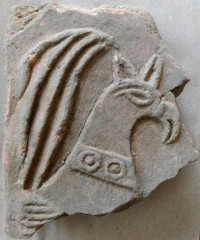Archaeologists Found the Mediaeval Cloister of the Monastery in Bakonybél
In Bakonybél, the archaeological excavation started last year was resumed in the first half of the summer. The most important result of the excavation directed by Szabolcs Balázs Nagy – lecturer, Institute of Archaeology, Eötvös Loránd University – is that it was the first time that the location and remains of the mediaeval monastery were successfully and clearly identified. The former cloister was found to the south of the present monastery. The wall-sections verify a building complex constructed in many periods around a regular quadrangle whose first present-day known stone walls could be dated for the 13th century with solid stratigraphic observations and finds. The building, which was abandoned involuntarily in the period of the Turkish occupation of Hungary, was repossessed by the Benedictines in ruined condition at the beginning of the 18th century. As for the present excavations, their church and monastery were constructed in the close vicinity of the former ruins (the southern wing of the Baroque monastery might have been built upon the foundation walls of the mediaeval church). From the point of view of the research, it is extremely propitious that no constructions were erected upon the former cloister, thus the walls hidden under the courtyard can relatively easily be examined.
Having been buried under the mediaeval monastery’s cloister, three human skeletons were excavated, presumably from the age of the Arpads. They seem to be the remains of adult men, the members of the Benedictine monastic community, or perhaps donors. The cloister was a burial place in other locations too (e.g. Pannonhalma). Graves were also found during the excavations last year. The examination of one of the skeletons with radiocarbon dating specified the burial’s interval between 1030 and 1160.
There was found a 12th-century floor-tile-fragment of half a palm representing a griffin, which probably belonged to the floor covering of the former church, and it relates to the similar floor tiles found in 1902. There were also found different carved stones, coloured shaped bricks, stove tiles, lead-line-fragments of windowpanes, book-clasps, fragments of glassware and pottery. The excavations revealed traces of an oven in addition to column-bases and storage-pits. Apart from these, a vaulted sewer of the 18th-19th centuries was found, which crosses the mediaeval cloister.
The archaeologist directing the excavation reported on the results in the blog of the Institute of Archaeology, Faculty of Humanities, Eötvös Loránd University: Ásónyomon. The first results were also published on the homepage of the Eötvös Loránd Research Network. https://www.elkh.org/hirek/a-vegehez-kozeledik-a-btk-szervezeseben-megva... The archaeologists kept on excavating the site of the nearby Holy Well (Szentkút [Borostyán-kő /Amber/]) as well, where they resume the work after a short break in autumn.
